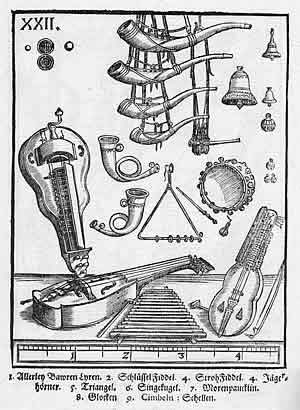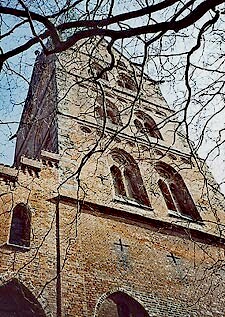|
Organ Of St. Pankratius In Hamburg-Neuenfelde
The organ of the St. Pankratius in Hamburg-Neuenfelde was built in 1688 by Arp Schnitger, and is his largest two-manual organ. The instrument has 34 stops, of which about half are original. Neuenfelde itself belongs to the Altes Land and was incorporated to Hamburg in 1937. Building history Schnitger was closely associated with Neuenfelde. He met his first wife here, whom he married in 1684. In 1693 he acquired the estate of his father-in-law Hans Otte in Neuenfelde and maintained another organ workshop, the so-called 'Orgelbauerhof', near Hamburg. He lived in Neuenfelde from 1705 at the earliest until his death in 1719, built his pew in St Pancras and was buried here.Edskes, Vogel (2016): ''Arp Schnitger and His Work.'' p. 146. Construction by Schnitger, 1688 In 1672–73, Hans Christoph Fritzsche had built an organ in Neuenfelde with 14 stops; this had been extended with an independent pedal after Fritzsche's death in 1674. When the church was rebuilt in 1682, Schnitger stored ... [...More Info...] [...Related Items...] OR: [Wikipedia] [Google] [Baidu] |
Neuenfelde St
is a rural quarter located in the borough Harburg of Hamburg, Germany near the Lower Saxony border. The quarter is well known for its quality of fruit and unique houses, many of which prove to be popular attractions for tourists passing through, it belongs to the ''Altes Land'' region and is quite known for the cherry and apple tree blossom. In 2020 the population was 4,883. History Neuenfelde as Nincop was first mentioned in 1257 as a village of Dutch settlers. In 1937 due to the Greater Hamburg Act Neuenfelde became a part of Hamburg. The survival of the settlement is currently under threat from the nearby Airbus factory and its airport. Over the past few years, Airbus extended their runway towards Neuenfelde. This upset local residents, many of whom have had to sell their properties in order to accommodate these plans. Another source of upset was the planned relocation of the local St. Pankratius church, home to a historic Baroque organ built by Arp Schnitger. On July 16, 200 ... [...More Info...] [...Related Items...] OR: [Wikipedia] [Google] [Baidu] |
Gustav Fock
Gustav Fock (18 November 1893 – 12 March 1974) was a German music historian, editor early music and organologist (musical instrumentologist). He is considered the most important Schnitger researcher of his time. Life and work Born in Neuenfelde, Fock was a captain's son from a family of seafarers in 1893. His father's name was Claus Hinrich Fock and he died early in 1913. His mother was Greta, ''née'' Fortriede, Tiedemann († 1969). Claus Hinrich Fock was the owner and skipper of the two-masted ships called "Cadet" and later "Greta". His lifelong fascination for Arp Schnitger - who was also born in Neuenfelde - and his encounter with Schnitger's organ there awakened his lifelong fascination for this organ builder. He attended the Royal Music Institute of Berlin in Berlin-Charlottenburg in 1919/20, then studied musicology with Max Seiffert at the Humboldt-Universität zu Berlin and with Fritz Stein in Kiel, where he was granted his doctorate in 1931 on "Hamburgs Anteil am Or ... [...More Info...] [...Related Items...] OR: [Wikipedia] [Google] [Baidu] |
Konrad Küster
Konrad Küster (born 11 March 1959) is a German musicologist. Born in Stuttgart, Küster studied musicology, Medieval and Modern History and Comparative Regional Studies at the Eberhard Karls University Tübingen and received his doctorate in 1989 with a thesis on the design of the first movements in Mozart's concerts (Kassel 1991). In 1993 he habilitated in Freiburg with the thesis ''Opus primum in Venice - tradition of the vocal movement, 1590-1650''. Since 1995 he has been professor of musicology at the Albert-Ludwigs-University of Freiburg. From 1995 to 1997 he was dean, and from 2002 to 2006 dean of studies. From 2003 to 2018 he was a member of the board of the International Heinrich Schütz Society. Küster's spectrum of research covers a wide range from the music of the Middle Ages to the Protestant musical culture of the 16th to 19th centuries (especially Heinrich Schütz and Johann Sebastian Bach) and on to First Viennese School. He became known as the editor of the '' ... [...More Info...] [...Related Items...] OR: [Wikipedia] [Google] [Baidu] |
Dorothea Schröder
Dorothea Schröder (born 25 April 1957) is a German musicologist. Life Born in Cuxhaven, Schröder studied musicology and art history in Hamburg. After obtaining her doctorate in 1986 in Hamburg and the habilitation in 1996, she taught there as ''privatdozentin'' in 1996 and as Professor of Historical Musicology in 2008. Publications (selection) * ''Zeitgeschichte auf der Opernbühne. Barockes Musiktheater in Hamburg im Dienst von Politik und Diplomatie (1690–1745)''. Göttingen 1998, . * ''Spaziergänge durch das musikalische London''. on WorldCat Zürich 1999, . * '' |
Tremulant
__NOTOC__ A tremulant (from Latin: ''tremulus'', "trembling"; french: tremblant, it, tremolo, es, temblor) is a device on a pipe organ which varies the wind supply to the pipes of one or more divisions (or, in some cases, the whole organ). This causes their amplitude and pitch to fluctuate, producing a tremolo and vibrato effect. A large organ may have several tremulants, affecting different ranks (sets) of pipes. Many tremulants are variable, allowing for the speed and depth of tremolo to be controlled by the organist. The tremulant has been a part of organ building for many centuries, dating back to Italian organs of the sixteenth century. The tremulant should not be confused with the celeste, which consists of two distinct ranks of pipes, one tuned slightly sharp or flat from the other, producing an undulating effect when they are used together. Construction The simplest kind of tremulant is a weighted electric motor affixed to the top of the reservoir for the division ... [...More Info...] [...Related Items...] OR: [Wikipedia] [Google] [Baidu] |
Organ Of St
Organ may refer to: Biology * Organ (biology), a part of an organism Musical instruments * Organ (music), a family of keyboard musical instruments characterized by sustained tone ** Electronic organ, an electronic keyboard instrument ** Hammond organ, an electro-mechanical keyboard instrument ** Pipe organ, a musical instrument that produces sound when pressurized air is driven through a series of pipes ** Street organ, a mobile, automatic mechanical pneumatic organ played by an organ grinder ** Theatre organ, a pipe organ originally designed specifically for imitation of an orchestra Films * ''Organ'' (film), a 1996 Japanese film about organ thieves * ''The Organ'' (film), a 1965 Slovak film Periodicals * Organ, any official periodical (i.e., magazine, newsletter, or similar publication) of an organization * ''Organ'' (magazine), a UK music magazine founded in 1986 * ''The Organ'' (magazine), a quarterly publication for organ enthusiasts, founded in 1921 * ''The Organ'' ( ... [...More Info...] [...Related Items...] OR: [Wikipedia] [Google] [Baidu] |
Meantone Temperament
Meantone temperament is a musical temperament, that is a tuning system, obtained by narrowing the fifths so that their ratio is slightly less than 3:2 (making them ''narrower'' than a perfect fifth), in order to push the thirds closer to pure. Meantone temperaments are constructed the same way as Pythagorean tuning, as a stack of equal fifths, but it is a ''temperament'' in that the fifths are not pure. Notable meantone temperaments Equal temperament, obtained by making all semitones the same size, each equal to one-twelfth of an octave (with ratio the 12th root of 2 to one (:1), narrows the fifths by about 2 cents or 1/12 of a Pythagorean comma, and produces thirds that are only slightly better than in Pythagorean tuning. Equal temperament is roughly the same as 1/11 comma meantone tuning. Quarter-comma meantone, which tempers the fifths by 1/4 of a syntonic comma, is the best known type of meantone temperament, and the term ''meantone temperament'' is often used to refer to i ... [...More Info...] [...Related Items...] OR: [Wikipedia] [Google] [Baidu] |
Michael Praetorius
Michael Praetorius (probably 28 September 1571 – 15 February 1621) was a German composer, organist, and music theorist. He was one of the most versatile composers of his age, being particularly significant in the development of musical forms based on Protestant hymns. Life Praetorius was born Michael Schultze, the youngest son of a Lutheran pastor, in Creuzburg, in present-day Thuringia. After attending school in Torgau and Zerbst, he studied divinity and philosophy at the University of Frankfurt (Oder). He was fluent in a number of languages. After receiving his musical education, from 1587 he served as organist at the Marienkirche in Frankfurt. From 1592/3 he served at the court in Wolfenbüttel, under the employ of Henry Julius, Duke of Brunswick-Lüneburg. He served in the duke's State Orchestra, first as organist and later (from 1604) as '' Kapellmeister'' (court music director). [...More Info...] [...Related Items...] OR: [Wikipedia] [Google] [Baidu] |
Rudolf Von Beckerath
Rudolf von Beckerath (19 February 1907 – 22 November 1976) was a German master organ builder. He was born in Munich, to the painter Willy von Beckerath, but grew up in Hamburg, where his family moved the year he was born. He initially pursued an interest in mechanical engineering. After encountering the quality of northern German pipe organs, particularly that of master builder Arp Schnitger, von Beckerath's interest shifted. He trained as a cabinet maker at the art school in Hamburg, while studying the fundamentals of organ building on his own. In the cellar of his parents' home, he built a small house-organ, which was heard in a radio broadcast from the house and in concerts there. His training continued in France, where he moved on the recommendation of Hans Henny Jahnn. In Châtillon-sous-Bagneux, near Paris, he entered the workshop of Victor Gonzalez. By the 1950s and 1960s, von Beckerath's own firm became one of the leaders of the Organ Reform Movement in Nor ... [...More Info...] [...Related Items...] OR: [Wikipedia] [Google] [Baidu] |
Aegidienkirche, Lübeck
The St.-Aegidien-Kirche or Aegidienkirche is a church building in the north German city of Lübeck, dedicated to saint Giles. It is the smallest and westernmost church in the city centre. It is first mentioned as dedicated to St Giles in 1227 - this is unusual for a north German and may link it to an earlier 1172-1182 wooden church built under bishop Henry I, formerly the abbot of the abbey dedicated to the same saint in Braunschweig. The church's coat of arms includes a "T", short for "Tilgenkark", the Low German form of the church's name, and "St Tilgen" or "St. Illigen", the Low German forms of the saint's name. It remained in the nearby cathedral chapter's control until the Protestant Reformation The Reformation (alternatively named the Protestant Reformation or the European Reformation) was a major movement within Western Christianity in 16th-century Europe that posed a religious and political challenge to the Catholic Church and in ..., when shortly after Easter 153 ... [...More Info...] [...Related Items...] OR: [Wikipedia] [Google] [Baidu] |
Organ Reform Movement
The Organ Reform Movement or ''Orgelbewegung'' (also called the Organ Revival Movement) was a mid-20th-century trend in pipe organ building, originating in Germany. The movement was most influential in the United States in the 1930s through 1970s, and began to wane in the 1980s. It arose with early interest in historical performance and was strongly influenced by Albert Schweitzer's championing of historical instruments by Gottfried Silbermann and others, as well as by Schweitzer's opinion that organs should be judged primarily by their ability to perform with clarity the polyphonic Baroque music of J. S. Bach (1685–1750). Concert organist E. Power Biggs was a leading popularizer of the movement in the United States, through his many recordings and radio broadcasts. The movement ultimately went beyond the "Neo-Baroque" copying of old instruments to endorse a new philosophy of organ building, "more Neo than Baroque". The movement arose in response to perceived excesses of symphon ... [...More Info...] [...Related Items...] OR: [Wikipedia] [Google] [Baidu] |

